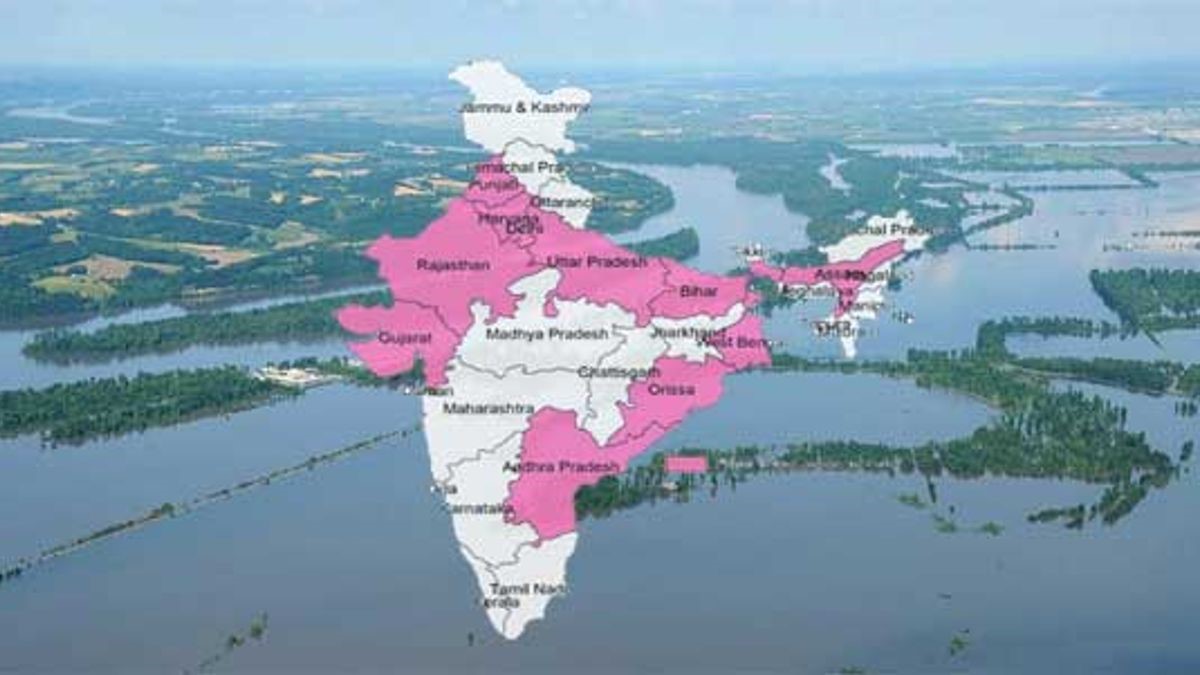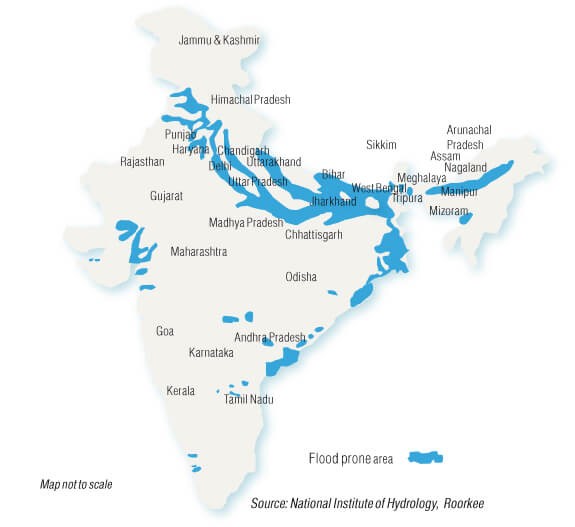Description

Disclaimer: Copyright infringement not intended.
Context
- India’s urban areas have been flooding more and more often, destroying lives and livelihoods.
- Yet, according to a study led by the World Bank and published in Nature recently, flood risk in many cities is rising because they are expanding into flood-prone areas.
Details
Causes of Floods in India
Heavy Rainfall:
- Heavy rains are the most common cause of flooding in India.
- From June to September, the monsoon season provides strong and irregular rainfall to various sections of the country.
- Floods occur when rainfall exceeds the capacity of the soil to absorb or the drainage system to transport away the surplus water.
- For example, from July 3-10, 2023, Delhi had 'excess' and 'big excess' rain on five of eight days. On July 9, it rained 221.4 mm, which was more than the 209.7 mm average for the month.
- This caused floods in many areas of the city.
Snowmelt:
- As temperatures rise, snow and glaciers in the mountains melt and flow into rivers and streams.
- This can raise the water level and create downstream flooding.
- In February 2021, for example, a large flash flood occurred in Uttarakhand as a result of a glacial burst that created an avalanche of snow, ice, and debris.
Cyclone and Storms:
- Cyclones and storms are weather occurrences that can bring severe winds and heavy rains to India's coastal districts.
- Storm surges are abrupt rises in sea level caused by low air pressure and high winds.
- Storm surges have the potential to inundate low-lying areas and create coastal flooding.
- Cyclone Amphan, for example, devastated West Bengal and Odisha in May 2020, with wind speeds of up to 185 km/h and storm surges of up to 5 meters.
River Overflow:
- This is a flood because that occurs when the water level in a river exceeds it carrying capacity due to excessive upstream inflow or decreased outflow downstream.
- Factors such as excessive rainfall, snowmelt, cyclones, dams, barrages, or siltation can all contribute to river overflow.
- For example, severe rainfall in upstream areas such as Himachal Pradesh and Haryana caused the Yamuna River to exceed its banks in 2023.
- The Delhi barrages were unable to efficiently manage and redirect the flow of the river, resulting in flooding in various areas along the river.
Impacts of Floods in India
Loss of Life:
- Flooding can result in fatalities due to drowning, injuries, illnesses, or electrocution.
- Floods are one of the most common and fatal natural disasters in India, according to the National Disaster Management Authority (NDMA).
- Floods claim the lives of approximately 1,600 people each year.
- Only halfway through 2023, at least 60 deaths have been documented as a result of floods in North India, while the true toll may be greater.
Damage to Property:
- Floods can cause damage or destruction to homes, buildings, roads, bridges, railways, electricity lines, communication networks, and other infrastructure.
- Floods can also destroy or damage crops, livestock, vehicles, and other valuables.
- Every year in India, floods affect around 75 lakh hectares of land and cause damage of Rs 1,805 crore to crops, residences, and public services, according to the NDMA.
- Floods in 2023 caused serious damage to various landmarks in Delhi, including the Red Fort and the Supreme Court.
.jpg)
Individuals displaced:
- Floods can compel individuals to flee their homes and seek refuge in safer places.
- This can interfere with their daily lives and livelihoods.
- Floods can also cause humanitarian disasters by disrupting access to food, water, sanitation, health care, and education.
- Floods displaced approximately 5.4 million people in India in 2020, according to the Internal Displacement Monitoring Centre.
- Floods in North India, particularly Himachal Pradesh and Punjab, affected thousands of people in 2023.
Environmental Degradation:
- Floods can have a harmful impact on the environment by eroding the soil, disrupting the natural habitats of flora and wildlife, polluting water sources, and raising the risk of landslides and epidemics.
- Floods have the potential to disrupt the biological balance of rivers and wetlands by altering their hydrology and biodiversity.
- Floods, for example, can harm the lives of endangered animals such as the Gangetic dolphin and the gharial in the Yamuna River.
Economic Losses:
- Floods can have an impact on India's economic growth and development by reducing agricultural output, disturbing industrial production, disrupting trade and commerce, and raising expenditure on relief and rehabilitation.
- Floods can also have an impact on the tourism industry by destroying cultural heritage and natural attractions. According to World Bank research, floods cost India over $14 billion in direct losses each year.
The Solutions for Flood Management in India
Storage Reservoirs:
- Storage reservoirs are man-made structures that retain water during periods of high flow and release it during periods of low flow.
- They can reduce the volume and velocity of water downstream, thus minimizing the flood peak.
Embankments:
- Embankments are elevated structures that restrict the flow of water within a channel or along a bank.
- They can safeguard the surrounding areas from floods by enhancing the river's carrying capacity or directing excess water to other channels.
- The Kosi embankment project in Bihar, for example, tries to minimize flooding by building embankments on both sides of the Kosi River.
Diversions:
- Diversions are constructions that redirect a portion or the entire flow of water from one channel to another.
- They can help to reduce flooding by directing excess water to less vulnerable locations or storage reservoirs.
- They can also supply irrigation and drinking water to other areas.
- The Indira Gandhi Canal, for example, diverts water from the Sutlej and Beas rivers to the Thar desert in Rajasthan for cultivation and drinking.

Finding on Flood Risks
- According to the paper, since 1985, human settlements in flood-prone areas have more than doubled.
- Experts say the findings spotlight the risk of unsustainable urbanization in India.
- The study also found that middle-income countries like India have more urban settlements in flood-prone zones than low- and high-income countries.
How is India at risk?
- India isn’t among the 20 countries whose settlements are most exposed to flood hazards, but it was the third highest contributor to global settlements, after China and the U.S., and also third after China and Vietnam among countries with new settlements expanding into flood-prone areas, all from 1985 to 2015.
- India is at significant risk of flood-related problems that could worsen in the coming years if the country isn’t careful.
- At the heart of flood-related hazards is where we build or expand our cities.
- For example, Bengaluru floods cost the city ₹225 crore.
- During the last century, the city’s population grew from around 1.6 lakh to more than a crore.
- To accommodate these people, the city expanded but new localities overlooked the local topography.
Who are the most affected?
- The risks are disproportionately higher for those living in informal structures.
- Informal housing in cities is on land that is vacant and less desirable so that they are not immediately driven off.
- So, they often lie in low-lying, flood-prone areas.
- An important reason why urbanization has expanded into flood-prone areas is that we don’t have the governance processes to say that this kind of development is environmentally unsustainable.
- When environmental regulations are applied to new constructions, they are often applied only to big infrastructure projects and not to medium and small-scale modifications of localities.
- This contradicts the notion that certain localities are more flood-prone and that flooding and flood risk are locality-level issues.
- People commonly violate existing government regulations.
- For example, there has been a rise in ecotourism resorts on forest land and the construction of large structures, including government buildings and even religious structures, on rivers’ floodplains.
.jpg)
What should be done?
- We can no longer avoid growing into flood-prone areas as cities continue to grow.
- Market factors tend to drive growth toward flood-prone locations.
- However, recognizing what these places are and that we are expanding into them is the first step toward risk-adjusted urban development.
- Some sorts of adaptation are required, and they must distinguish between low-income people and unauthorized structures built for the privileged.
- Examples of local and sustainable housing models include riverside settlements that use stilt houses, like those used by the Mishing and the Miyah communities along the Brahmaputra.
- Every city needs to do a proper scientific mapping of the flood-prone areas.
- Urban governments need to make housing in such areas more flood-resilient and protect low-income housing.
Conclusion:
- Moving habitations from low-lying, flood-prone areas to higher grounds, regulating them, and building ecologically and economically sustainable houses for the poor will contribute towards sustainable development goal number 11, i.e., sustainable cities and communities.
|
PRACTICE QUESTION
In India, assess the role of structural and non-structural measures in flood management. What are the potential and challenges for water conservation in the context of climate change?
|















